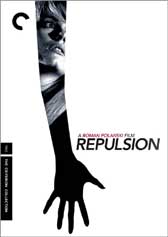 REPULSION
(1965)
REPULSION
(1965)Director: Roman Polanski
The Criterion Collection
 REPULSION
(1965)
REPULSION
(1965)In the first half of the 1960s, Compton Films – a British company run by Tony Tenser and Michael Klinger – exhibited and distributed a wide assortment of international exploitation product, as well as producing occasional mondo nudies and costume horror films. Looking for financing for a new project, Compton warmly welcomed producer Gene Gutowski and his friend, Polish born filmmaker Roman Polanski, when nearly every other potential outfit turned them away. Though Polanski only had one full-length feature under his belt – the critically acclaimed and Oscar-nominated KNIFE IN THE WATER – Compton immediately recognized the prestige in backing a film with his name on it, even if a script was yet to be fully realized. REPULSION would become Polanski’s second feature and first one shot in English, and the attention and praise it garnered helped establish him as an auteur adept at clever thrillers and the odd genre effort.

In the West End of London, young Belgian manicurist Carole Ledoux (Catherine Deneuve) lives in a flat with her older sister, Hélène (Yvonne Furneaux, THE MUMMY). Carole is a pure and repressed young woman, totally uninterested in the rude men who make passes to her on the street, and a cold fish when it comes to giving any affection to her smitten and seemingly affable boyfriend Colin (John Fraser, A STUDY IN TERROR). When Hélène decides to leave town for a few days with her married lover Michael (Ian Hendry, THEATRE OF BLOOD), Carole’s unhinged mind slowly deteriorates as she is left alone to fend for herself, locking out the external world and conjuring up wild hallucinations that reflect her disgust towards sex and her abhorrence of men.
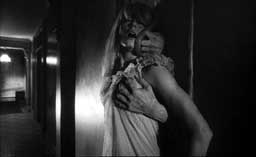 Written
by Polanski and collaborator Gerad Bach, REPULSION doesn’t really have
a complex storyline and its intentionally slow pacing doesn’t allow the
film to really become a spectacle until Carole is left alone in the apartment.
But as a whole, its quite a remarkable film, and anything but a conventional
horror programmer. Purportedly, Polanksi was so meticulous during the shoot
that he not only went over schedule, but he also went over budget. But the outcome
is well reflected on screen, as his creative freedom was allowed to flow (that
is, within the restraints of the budget allotted him). Carole’s distorted
persona and increasing schizophrenia are at first illustrated with such simple
but effective objects as a skinned rabbit sitting out on a tray for days, rotting
potatoes or a fly buzzing around. It’s Carole’s inner madness that
allows for some stunningly haunting imagery (with the help of art director Seamus
Flannery) and her once cheery flat to become a gloomy, low-lit house of horrors.
Carole envisions the walls cracking abruptly, the hallways expanding, and best
of all, a cluster of mutated arms protruding from the walls with the intentions
of aggressively groping her.
Written
by Polanski and collaborator Gerad Bach, REPULSION doesn’t really have
a complex storyline and its intentionally slow pacing doesn’t allow the
film to really become a spectacle until Carole is left alone in the apartment.
But as a whole, its quite a remarkable film, and anything but a conventional
horror programmer. Purportedly, Polanksi was so meticulous during the shoot
that he not only went over schedule, but he also went over budget. But the outcome
is well reflected on screen, as his creative freedom was allowed to flow (that
is, within the restraints of the budget allotted him). Carole’s distorted
persona and increasing schizophrenia are at first illustrated with such simple
but effective objects as a skinned rabbit sitting out on a tray for days, rotting
potatoes or a fly buzzing around. It’s Carole’s inner madness that
allows for some stunningly haunting imagery (with the help of art director Seamus
Flannery) and her once cheery flat to become a gloomy, low-lit house of horrors.
Carole envisions the walls cracking abruptly, the hallways expanding, and best
of all, a cluster of mutated arms protruding from the walls with the intentions
of aggressively groping her.

French actress Deneuve was Polanski’s hand-picked choice for the role, and he had to convince the British backers to let her be cast and cough up her required salary (most of the English speaking population have never heard of her at the time). In an almost silent role, she does a commendable job of conveying a deeply disturbed character through childlike mannerisms (chewing her hair, biting her nails, tapping her nose) and her ultimate breakdown which is shown through the surreal hallucinations that occur, including repeated sexual assault by the man who made a pass at her on the street. Though Deneuve didn’t wear much make-up during the character’s decline, she still emerges as one of the most beautiful women you’ll ever see on screen. Outwardly, a flaxen lamb in a nightgown constrained to a trance-like state, the beauty of Carole juxtaposed with the dreadfulness that’s inside, makes the character all the more disturbing, especially with the few men she comes into contact with hopelessly fawning over her, not realizing that doing so could make them a fatality.
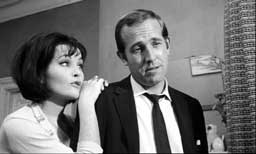 Polanski
is able to pull off quite a few chills here, especially when Carole sees the
reflection of a man in her wardrobe mirror, only to quickly turn around and
not find him. As later evidenced during the climax of ROSEMARY’S BABY,
the director also has a flair with leaving something to the imagination as a
more effective approach to pull off a shock. A good example is when Michael
(Ian Hendry) returns from his trip to discover something very unpleasant in
the bathroom: the audience never sees it, but knows exactly what is, courtesy
of a prior scene, and thus has to visualize it in their head (Hendry plays the
scene brilliantly). Though the film is basically a showcase for Deneuve and
the character study of Carole, the fine supporting cast of British actors include
Renee Houston, Valerie Taylor, James Villiers (BLOOD FROM THE MUMMY’S
TOMB), Helen Fraser and most impressively Patrick Wymark (THE SKULL) as a sleazy
landlord who harasses Carole in a pivotal scene. The stark black and white cinematography
by Gilbert Taylor and a sometimes very jazzy but always moody score by Chico
Hamilton further enhance this unforgettable early work by one of the world’s
most recognized and consistently superior directors.
Polanski
is able to pull off quite a few chills here, especially when Carole sees the
reflection of a man in her wardrobe mirror, only to quickly turn around and
not find him. As later evidenced during the climax of ROSEMARY’S BABY,
the director also has a flair with leaving something to the imagination as a
more effective approach to pull off a shock. A good example is when Michael
(Ian Hendry) returns from his trip to discover something very unpleasant in
the bathroom: the audience never sees it, but knows exactly what is, courtesy
of a prior scene, and thus has to visualize it in their head (Hendry plays the
scene brilliantly). Though the film is basically a showcase for Deneuve and
the character study of Carole, the fine supporting cast of British actors include
Renee Houston, Valerie Taylor, James Villiers (BLOOD FROM THE MUMMY’S
TOMB), Helen Fraser and most impressively Patrick Wymark (THE SKULL) as a sleazy
landlord who harasses Carole in a pivotal scene. The stark black and white cinematography
by Gilbert Taylor and a sometimes very jazzy but always moody score by Chico
Hamilton further enhance this unforgettable early work by one of the world’s
most recognized and consistently superior directors.
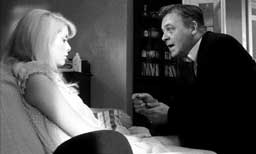
Thankfully, the U.S. copyright owner, Sony Pictures Home Entertainment (Columbia Pictures distributed the film in the U.S. under a subsidiary) licensed the film to The Criterion Collection, because its very deserving of their exceptional treatment. Also being released simultaneously on Blu-ray, Criterion has done a director-approved high definition transfer from the original 35mm negative, a 35mm composite fine grain master positive and a 35mm duplicate negative. Needless to say, the film looks spectacular, presented anamorphic in a nicely framed 1.66:1 widescreen presentation. The black and white image detail is very sharp and has truly deep black tones. There is very little, if any grain, and all dirt, debris and other defects are none to be found. The mono audio has also been cleaned up a great deal, so it’s pretty much flawless as well, and there’s optional English subtitles/captions included.
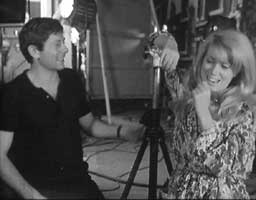 A
handful of supplements have been included, all of them solid and very enjoyable.
A running audio commentary with Polanksi and Deneuve (recorded separately) was
originally conducted in 1994 for Criterion’s laserdisc release. The commentary
has held up well, with Polanski getting the majority of the spotlight, and Deneuve
chiming in from time to time with informative passages about her character and
her experience on the film. Polanski is pleasingly thorough and a delight to
listen to, though surprisingly, he calls REPULSION, “the shabbiest of
my films”. “Grand Ecran” (21:27), is a short black & white
documentary directed by Claude Chaboud and originally shown on French TV, and
it’s something of a treasure. With limited narration (in French with English
subtitles), Polanski is seen directing some of the cast members, having congenial
on-the-set conversations with Deneuve, and being interviewed at the local pub.
Deneuve and Furneaux are also seen interviewed (all of them speaking in French,
with accompanying English subtitles). Observing him in action, it’s easy
to see that the director is passionate about his work, but at the same time
displaying a boyish charm which caused him to get along well with the cast and
crew. Directed by David Gregory for Blue Underground in 2003, “A British
Horror Film” (24:02) is an excellent featurette which contains on-camera
interviews with Polanski, cinematographer Gil Taylor, art director Seamus Flannery,
producer Gene Gutowski and executive producer Tony Tenser (who passed away in
2007). A number of anecdotes are unveiled, and Taylor and Flannery in particular
express the dedication they gave to the project, both having mutual admiration
for the director and realizing they were working on something out of the ordinary.
The exploitive British and American trailers round out the extras, and there’s
a booklet containing a fine essay (appropriately titled, “Eye of the Storm”)
by Bill Horrigan. (George
R. Reis)
A
handful of supplements have been included, all of them solid and very enjoyable.
A running audio commentary with Polanksi and Deneuve (recorded separately) was
originally conducted in 1994 for Criterion’s laserdisc release. The commentary
has held up well, with Polanski getting the majority of the spotlight, and Deneuve
chiming in from time to time with informative passages about her character and
her experience on the film. Polanski is pleasingly thorough and a delight to
listen to, though surprisingly, he calls REPULSION, “the shabbiest of
my films”. “Grand Ecran” (21:27), is a short black & white
documentary directed by Claude Chaboud and originally shown on French TV, and
it’s something of a treasure. With limited narration (in French with English
subtitles), Polanski is seen directing some of the cast members, having congenial
on-the-set conversations with Deneuve, and being interviewed at the local pub.
Deneuve and Furneaux are also seen interviewed (all of them speaking in French,
with accompanying English subtitles). Observing him in action, it’s easy
to see that the director is passionate about his work, but at the same time
displaying a boyish charm which caused him to get along well with the cast and
crew. Directed by David Gregory for Blue Underground in 2003, “A British
Horror Film” (24:02) is an excellent featurette which contains on-camera
interviews with Polanski, cinematographer Gil Taylor, art director Seamus Flannery,
producer Gene Gutowski and executive producer Tony Tenser (who passed away in
2007). A number of anecdotes are unveiled, and Taylor and Flannery in particular
express the dedication they gave to the project, both having mutual admiration
for the director and realizing they were working on something out of the ordinary.
The exploitive British and American trailers round out the extras, and there’s
a booklet containing a fine essay (appropriately titled, “Eye of the Storm”)
by Bill Horrigan. (George
R. Reis)